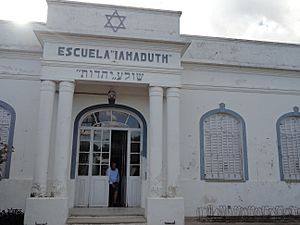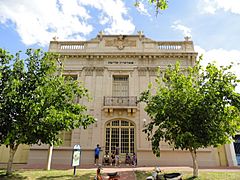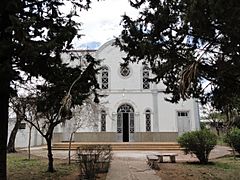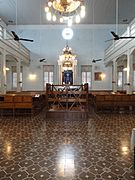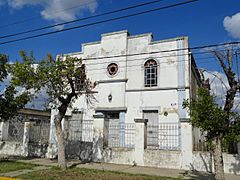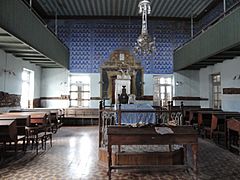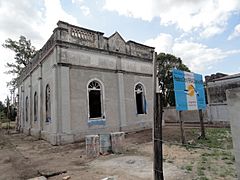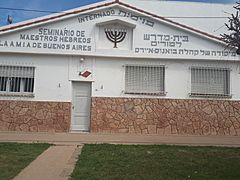Moisés Ville facts for kids
Quick facts for kids
Moisés Ville
|
|
|---|---|
|
Comuna
|
|
| Country | Argentina |
| Province | Santa Fe |
| Department | San Cristóbal |
| Area | |
| • Total | 291 km2 (112 sq mi) |
| Elevation | 83 m (272 ft) |
| Population
(2010)
|
|
| • Total | 2,425 |
| • Density | 8.333/km2 (21.58/sq mi) |
| Demonym(s) | moisesvillense |
| Time zone | UTC-3:00 (Argentina Time) |
| Postal code |
S2313
|
| Area code | 03409 |
Moisés Ville is a small town in the province of Santa Fe, Argentina. It was started on October 23, 1889. The town was founded by Jewish people from Eastern Europe and Russia. They came to Argentina to escape difficult times and unfair treatment in their home countries.
The original name planned for the town was Kiryat Moshe, which means "Town of Moses" in Hebrew. This name honored Baron Maurice Moshe Hirsch. However, the person who registered the settlement changed the name to Moïsesville, which sounded French. Later, it became the Spanish Moisés Ville. The town is about 177 kilometers (110 miles) from the capital city of Santa Fe. It is also about 616 kilometers (383 miles) from Buenos Aires. In 2010, about 2,425 people lived there.
Contents
History of Moisés Ville
Moisés Ville was founded by a group of Jewish immigrants from Russia. They arrived in August 1889 on a ship called the SS Weser. They came from a place called Kamenetz-Podolsk in Ukraine. Moisés Ville is thought to be the first Jewish farming community in South America. It was started a few months before a smaller group from Bessarabia created a nearby settlement called Monigotes.
Planning the Journey
The idea for the settlement began in 1887. Leaders of Jewish communities met in Katowice, Poland. They wanted to find a solution to their problems. They decided that moving to Palestine was the answer. They chose Eliezer Kauffman to go to Paris. He was supposed to meet Baron Edmond James de Rothschild and ask for his help.
There are two ideas about what happened next. Some say the Baron did not agree to help. Others believe Kauffman could not even meet him. Kauffman was worried about going back without good news. He learned about an office for information about the Argentine Republic. He met J. B. Frank, who worked there. Kauffman found out that a man named Rafael Hernández wanted to sell land to European immigrants. This land was in an area called Nueva Plata, near La Plata. A contract was signed for the 820 people Kauffman represented. This included 130 families, which was half of Argentina's Jewish population at the time. They began their trip to Argentina on the SS Weser.
Arrival and Challenges
The immigrants arrived in Buenos Aires on August 14, 1889. They quickly learned that the land they had bought was not available. The price of the land had more than doubled since their agreement. This made it difficult for Hernández to keep his promise. Rabbi Henry Joseph, a leader of the Jewish community in Argentina, tried to help. He arranged for the new arrivals to meet Pedro Palacios. Palacios was the Jewish Community's lawyer and owned a lot of land in Santa Fe. This land was near where a new railway line to Tucumán was being built. Palacios agreed to sell some of his land to the Weser passengers.
By late August, contracts were signed, and the immigrants were on their way. But their journey was hard, and the place they arrived at was even worse. The families had to stay in freight cars parked in a shed by the railway. They expected to move to their farms and get animals and tools, as their contract said. But none of this happened. Railway workers gave food to the hungry children. Soon, a serious illness called typhus spread. It was made worse by poor hygiene. This illness caused 64 deaths.
Two cemeteries were built very quickly, one in Palacios and one in Monigotes. These cemeteries helped form the Jewish community. They made the Jewish immigrants feel connected to the land. The families decided to stay and not leave the resting places of their loved ones.
Help Arrives
The government learned about the terrible conditions of the immigrants. They ordered an investigation. Luckily, Wilhelm Loewenthal, a doctor from Romania, was in Argentina. He was hired by the Argentine government for a science project. He was also asked to check on the Weser immigrants. He went to Palacios Train Station. He was shocked by how badly the immigrants were living. Even with all their problems, the settlers still hoped to become farmers.
Dr. Loewenthal reported to the Minister of Foreign Affairs, Estanislao Zeballos. He also asked Palacios to keep his promises. Back in Paris, Dr. Loewenthal suggested a plan to Rabbi Zadoc Kahn. He proposed creating an association to help Jewish families farm in Argentina. Each family would get a farm of 50 to 100 hectares. This would cost about US$2000 per family. If it weren't for the travelers stuck at Palacios Station, Baron Hirsch might not have thought of sending more Jewish people to Argentina. He also might not have created the Jewish Colonization Association (JCA). But because of this difficult experience, Baron Hirsch's plan was created in 1891.
Growth of the Colony
As part of the JCA's plan, another group of 42 families arrived in Moisés Ville between 1894 and 1895. These colonists settled in small villages near Moisés Ville. The villages were named after how many houses they had: "The Four Houses," "The Six Houses," "The Twelve Houses," and "The Twenty-four Houses."
In 1900, the colonists asked the JCA to make the colony bigger and bring more groups from the Grodno area. A colonist named Noe Cociovich helped with this. In 1900, 1901, and 1902, he made several trips to Russia. He brought back three groups, totaling 104 families. These families met the JCA's requirements: they had relatives in the colony and paid for their own tickets. These groups settled in areas like Wavelberg, Virginia, and La Juanita.
In 1901, another group of 31 families arrived from Białystok (now in Poland). This group was led by the writer Gdalia Bublik. The area where they settled is called Línea Białystok. Many of these colonists later moved to the town of Las Palmeras. At the same time, a group of families from Romania arrived, chosen by the JCA. They settled in the Zadok Kahn area, named after the Chief Rabbi of Paris. Most of these colonists also eventually moved to Las Palmeras.
Dr. Guillermo Lowenthal heard that there were plans to move the settlement to new places. But the people of Moisés Ville refused. They did not want to leave the place where they were already building a third cemetery. They wanted to stay where they were. They also decided to bring the children they had buried in Monigotes and Palacios to Moisés Ville.
More Immigrants Arrive
In 1903, after a difficult event called the Kishinev pogrom, another group from Bessarabia was formed. This group settled in the Mutchnik area, northwest of Moisés Ville. In 1905, a group from Kherson Governorate, Ukraine, settled in the Monigotes area. Later, the Capivara area was settled.
In the 1930s, Jewish people from Germany began to arrive. They were escaping unfair treatment by the Nazis. This continued until World War II started. After the war, several families who were refugees from the Netherlands and Germany arrived. Most of them were sent by the JCA.
The first groups of colonists settled around a growing town center. In 1894, this center had three main buildings: the synagogue, the JCA administration house, and the public baths. The colonists' homes were built around these buildings along three streets. The plots of land were 100 meters wide and 1,000 meters deep. Moisés Ville became famous as the home of the Jewish gauchos. These were Jewish farmers who worked the land in Argentina in the late 1800s and early 1900s.
Moisés Ville, along with its sister colonies of Mauricio and Clara, were important examples of the work of Baron Maurice de Hirsch's Jewish Colonization Association.
Moisés Ville Today
In recent times, Moisés Ville has started new projects. For example, Provincial Highway 69S has been repaved. This road connects the town to National Highway 34 through Palacios, a small village about 16 kilometers (10 miles) away.
Many tourists visit the town from other parts of Argentina and from overseas. Moisés Ville is one of the traditional towns in the "Pueblos Auténticos" program. This program was started by the Argentinian government in 2017. Its goal is to encourage tourism in rural areas.
Moisés Ville has a museum that keeps the history of Jewish settlement in the region alive. The town is also trying to be recognized by UNESCO as a world heritage site.
Important Buildings
- Iahaduth school
- Kadima theater
- Baron Hirsch Library
- Arbeter, Baron Hirsch, and Brener synagogues
- Aaron H. Goldman museum
- Jewish cemetery
- The students’ residence
- The hospital
Famous People from Moisés Ville
See also
 In Spanish: Moisés Ville para niños
In Spanish: Moisés Ville para niños



